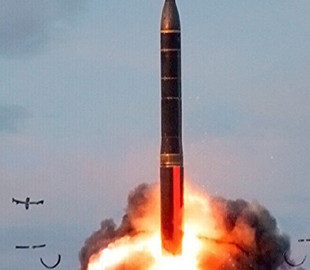
The Financial Times has investigated which Western companies' equipment Russia uses to produce the Oreshnik medium-range ballistic missile, Ukrainian Pravda reports.
This is reported by the Financial Times.
“According to the FT analysis, Vladimir Putin's experimental Oreshnik missile, launched against Ukraine last month, was manufactured by Russian companies that still rely on modern Western manufacturing equipment.”
The publication writes that two leading Russian military engineering institutes, named by Ukrainian intelligence as the developers of “Oreshnik”, advertised for employees familiar with metalworking systems of German and Japanese companies.
In particular, vacancies for the Moscow Institute of Thermal Engineering (MIT) and Sozvezdie, which were tracked by the Financial Times, illustrate that Russia remains critically dependent on foreign technologies that are subject to Western sanctions.
“This dependence is particularly noticeable in the area of computer numerical control (CNC) – a technology vital to the production of the Oreshnik, which allows factories to quickly shape materials with high precision, using computers to control tools,” the article says.
The publication investigated that the 2024 announcements of MIT, the leading institution for the development of Russian solid-fuel ballistic missiles, note that “we adhere to Fanuc, Siemens, Haidenhein”.
Fanuc is a Japanese company, and the other two are German. All three companies produce control systems for high-precision CNC machines.
These same three Western companies are mentioned in advertisements by Sozvezdiya, which lists “automated control and communication systems” for military use as one of its specializations. The ad requires “knowledge of CNC systems – Fanuc, Siemens, Haidenhain”.
A video released earlier this year by Titan Barrikady, the third defense company involved in Oreshnik production, also shows a worker standing in front of a control device marked Fanuc.
“Russia has long relied on foreign-made machine tools, despite efforts to create domestic alternatives. While the Kremlin buys large quantities of high-precision metalworking machines from China, their control systems continue to come from the West,” the FT writes.
It is noted that in 2024, eight Chinese companies presented 12 models of CNC devices at a major Russian exhibition. According to an analysis by the Economic Security Council of Ukraine, 11 of these models were equipped with Japanese or German-made controllers.
Vacancy ads also show that the Stan company, which is leading Russia's attempts to build a domestic CNC manufacturing industry, uses Heidenhain equipment.
“Stopping the flow of CNC controllers and equipment to Russia is a priority for Kyiv's allies. CNC devices and components are included in the so-called “joint list of high-priority goods”, the supply of which they especially want to deny to Moscow,” the article notes.
Although export controls have slowed the flow of these goods to Russia, an analysis of Russian declarations by the publication shows that since the beginning of 2024, at least $3 million worth of shipments have arrived in Russia, including Heidenhain components. Some of their buyers are deeply involved in military production.
One of the shipments was listed as being for a system that included Heidenhain's new TNC640 control unit, manufactured in 2023. According to Heidenhain's website, the TNC640 “define a high-end range of control technology in its industry” and “enables combined milling, turning and grinding operations.”
The machine, worth $345,000, was shipped via China to Baltic Industrial Company, a Russian company under U.S. sanctions that has a history of supplying CNC machines to the defense industry.
Heidenhain and Baltic did not respond to requests for comment.
Siemens said it “does not compromise on compliance” and is investigating “any signs of circumvention … and is engaging the necessary and appropriate organs”.
Fanuc acknowledged that the machine photographed on the “Titanium Barricade” was similar to theirs, but noted that it appeared to be old.
They said they had “increased vigilance and controls” within our export control processes to prevent the potential diversion of technology or equipment to Russian entities.

